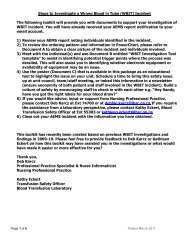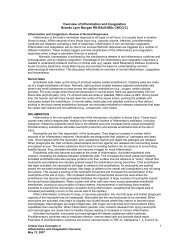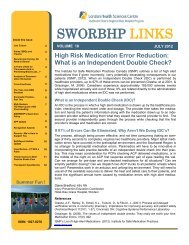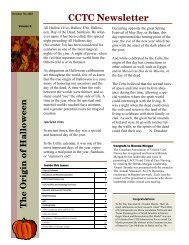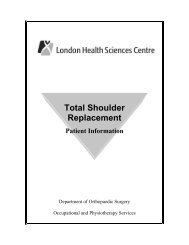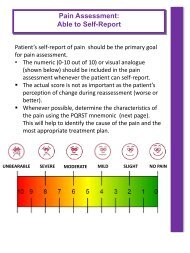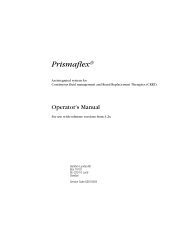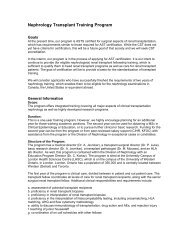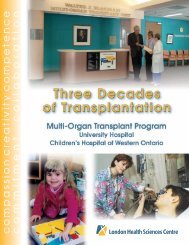Nursing Tip Sheet for Patients on HFOV (High Frequency Oscillatory ...
Nursing Tip Sheet for Patients on HFOV (High Frequency Oscillatory ...
Nursing Tip Sheet for Patients on HFOV (High Frequency Oscillatory ...
You also want an ePaper? Increase the reach of your titles
YUMPU automatically turns print PDFs into web optimized ePapers that Google loves.
11. Chest wiggle is present <strong>on</strong> <strong>HFOV</strong> from clavicular to mid- thigh bilaterally. If a<br />
change in chest wiggle occurs a RRT needs to be notified immediately. Unilateral<br />
wiggle-may indicate right main-stem intubati<strong>on</strong> or pneumothorax.<br />
Decrease Bilateral wiggle-may indicate change in lung compliance, lung/airway<br />
resistance or need <str<strong>on</strong>g>for</str<strong>on</strong>g> sucti<strong>on</strong>ing.<br />
12. Documentati<strong>on</strong>; hourly chest wiggle and sound, hourly Mean airway pressure<br />
(mPaw), hourly amplitude and Hertz (frequency) hourly- nurses will chart this from<br />
the oscillator. Chest wiggle and sound will be documented <strong>on</strong> the A & I with<br />
descripti<strong>on</strong> as well as <strong>on</strong> the flowsheet. The descripti<strong>on</strong> of chest wiggle and sound<br />
can be difficult so <strong>on</strong> shift change, per<str<strong>on</strong>g>for</str<strong>on</strong>g>m an assessment of chest wiggle and<br />
sound with <strong>on</strong>coming shift or any<strong>on</strong>e covering patient. Some traditi<strong>on</strong>al audible<br />
alarms may not be available <strong>on</strong> the <strong>HFOV</strong> <strong>on</strong>ly visual by flashing lights. Notify<br />
RRT immediately if alarm activated.<br />
13. Head movement or repositi<strong>on</strong>ing may cause a <strong>HFOV</strong> to alarm and stop. Be very<br />
careful when repositi<strong>on</strong>ing the patient’s head.<br />
14. The circuit of the <strong>HFOV</strong> must always remain straight, not kinked or twisted<br />
because it will increase impedance.<br />
15. Heart, lung and bowel sounds will not be able to be heard over the noise of the<br />
<strong>HFOV</strong>. Try to collaborate with the RRT and MD to listen at the same time by<br />
having the RRT turn off the pist<strong>on</strong> of the <strong>HFOV</strong>. Stopping the pist<strong>on</strong> stops the<br />
c<strong>on</strong>stant mean airway pressure from being maintained.<br />
16. Sucti<strong>on</strong>ing requires the assistance of the RRT as the pist<strong>on</strong> <strong>on</strong> the <strong>HFOV</strong> must be<br />
stopped and the RRT may need to per<str<strong>on</strong>g>for</str<strong>on</strong>g>m a lung recruitment strategy post<br />
sucti<strong>on</strong>ing. Sucti<strong>on</strong>ing should be avoided the first 12-24 hours to encourage lung<br />
recruitment.<br />
17. PPE- Use additi<strong>on</strong>al precauti<strong>on</strong>s-Please wear a face mask with shield when in the<br />
room with a patient <strong>on</strong> <strong>HFOV</strong>. (within 1 meter of patient).<br />
Prepared by;<br />
Gina Souliere RN BScN<br />
September 2009.<br />
Reviewed; March 29, 2010.<br />
References:<br />
1. VIASYS Healthcare. Initial Clinical Guidelines <str<strong>on</strong>g>for</str<strong>on</strong>g> <strong>HFOV</strong> 3100B in Adults: March<br />
2002<br />
2. Derdak S, Mehta S, Stewart T, Smith T, Rogers M, Buchman T, Carlin B, Lows<strong>on</strong><br />
S, Grant<strong>on</strong> J. <strong>High</strong>-<strong>Frequency</strong> <strong>Oscillatory</strong> Ventilati<strong>on</strong> <str<strong>on</strong>g>for</str<strong>on</strong>g> Acute Respiratory<br />
Distress Syndrome in Adults; A Randomized, C<strong>on</strong>trolled Trial. Am J Respir Crit<br />
Care Med 2002; 166: 801:808<br />
3. Mehta S, Lapinsky S, Hallet D, Merker D, Groll R, Cooper A, MacD<strong>on</strong>ald R,<br />
Stewart T. Prospective Trial of <strong>High</strong>-<strong>Frequency</strong> Oscillati<strong>on</strong> in Adults with Acute<br />
Respiratory Distress Syndrome. Crit Care Med 2001; 29; 7; 1360-1369



